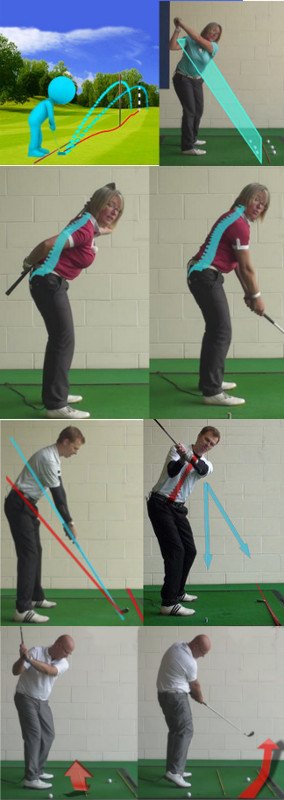- The path your club takes as you start your backswing is usually the same path it returns on. Bring it inside and it will more often than not come back more inside than out. Take it away outside and look out…the path will ALWAYS end up coming back outside to in.
- Get your spine angle correct. Then rotate your shoulders around your spine as you start your backswing. This rotation comes from your shoulder turn. Now you need something to get the swing plane. This is where your right elbow comes into play. In your backswing, right when your club is perpendicular to the ground, cock your wrists and bend your elbow at the same time. When you get to the top of your backswing your right forearm should be pointing straight to the sky. If you are able to get your left shoulder under your chin at this point, you are halfway to having a classic Ben Hogan swing plane.
- On your downswing think about dropping the club head by leading downward with your right elbow. Of course, this is happening almost simultaneously while your shoulders are springing into action. The combination of; shoulders returning, elbow dropping into the right plane and the lag being released at the right time dictate your swing plane.
- Practice your golf swing without a club in your hands. Feel what it is like to get your shoulders turning around your spine. Stretch your left shoulder under your chin. Get those wrists cocked and ready to come unhinged at just the right time. Sometimes the golf club just gets in the way of your great swing. Try developing your swing without the club first. Then when you think you’ve got it right, introduce the club back into your practice routine.
- Never stop working on your swing plane. Something as simple as having tired muscles affects our swing plane. Recognize these things and be prepared for your shortcomings. Develop swing thoughts that will help you through times when your swing is off plane.
- Your swing path is what dictates the shape of your shot. An outside in swing path usually creates a strike with an open club face that balloons high and right. An inside out swing path can still go to the right if the club face is not squared up through the impact zone, but it will not be a weak slice. It will be a solid push into the trees. An inside out swing path is the desired path for trying to draw the ball.
- Last but not least…when you do get it right, for heaven’s sake, get it on film. Trust me. You will thank me someday.

Before I get started I have to say that I believe that any conversation regarding swing path must begin with a proper swing plane. If your swing is on plane, the path your club head takes will be a symbiotic relationship with the swing plane. There was a time about 15 years ago when my ball striking was impeccable. I just knew where the ball was going to go even before I chose how I was going to get it there. The reason for that was my unwavering confidence in my swing plane and swing path. The sad thing is that I took this all for granted. What I should have done was to take extensive video of my swing at that time. No problem, I thought. My swing will always be this way. Wrong. Over the winter I developed Type 2 diabetes. I couldn’t swing hard and maintain my balance any more. The result was a loss of some 50 yards off my driver and two full clubs as far as my irons are concerned. My swing plane, which was once a repeatable thing of beauty, was reduced to a slash and hack attempt to get around the golf course. For the past 15 years I have been trying to reproduce that elusive swing plane. There are days when I think I have it again and then…poof…it’s gone again. What I have learned I will share with you.
In summary, I hope that you recognize the importance of developing a proper swing plane/path. It is truly the fuel that drives the engine that is our golf swing.





